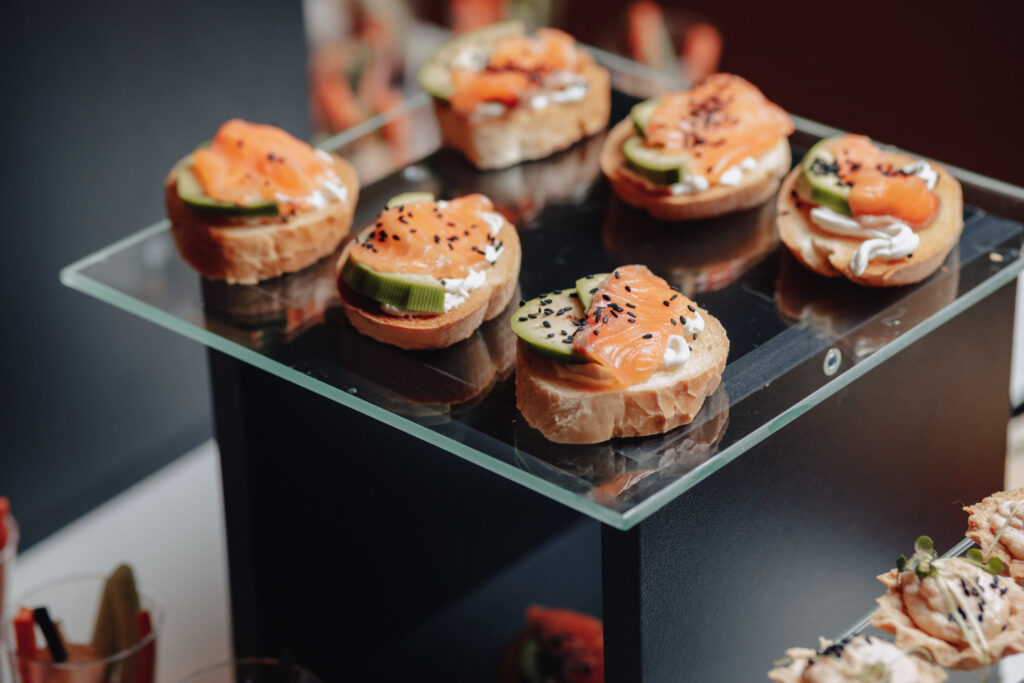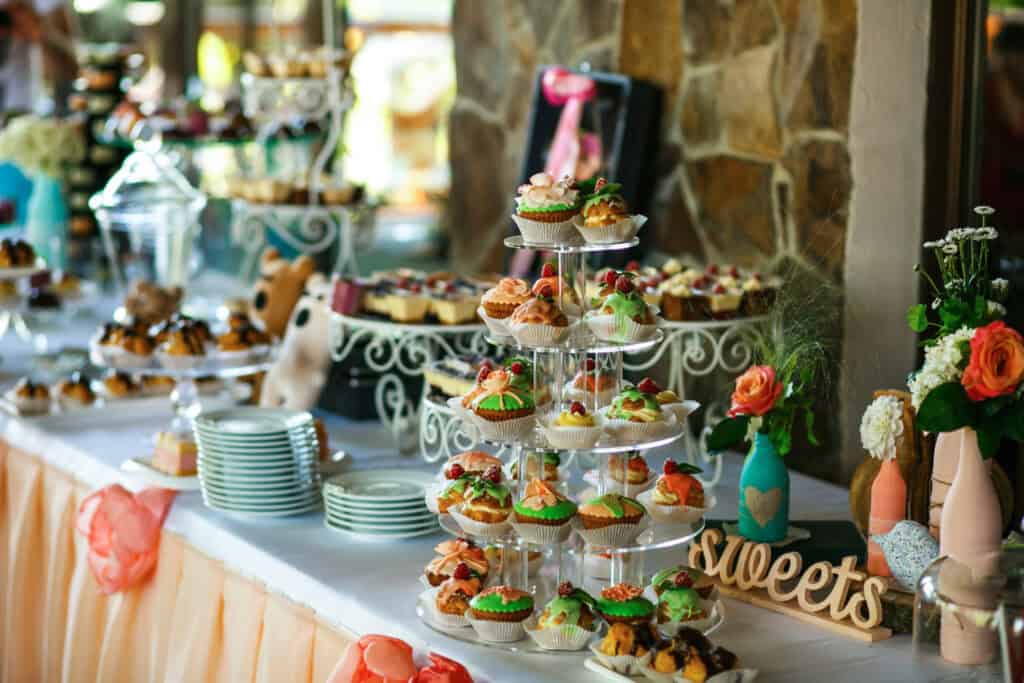
By Jermaine Thomas July 3, 2025
Food presentation is more than just an aesthetic choice. In the world of catering and event planning, how food looks plays a significant role in shaping the guest experience. From intimate barn weddings to lavish corporate galas, the visual design of your spread can either enhance or clash with the overall venue atmosphere. Understanding how to tailor food displays to different environments ensures your service feels intentional and professional.
As customer expectations rise and event photography becomes a central part of marketing, the emphasis on venue-appropriate food styling has only grown. People no longer want just good food; they want visually cohesive experiences. Whether your client wants a rustic backyard event or a five-star ballroom reception, aligning food aesthetics with venue style enhances the sensory appeal and creates lasting impressions.
Understanding Venue-Based Catering Design
Every venue tells a story and your catering presentation should tell that story. From lighting and tableware to wall textures and layout the environment sets the tone. Matching the style of food presentation to the venue type will create cohesion and guest engagement.
Venue Type and Food Style
A garden venue requires natural, earthy presentation. Wooden boards, glass jars and linen runners work in the environment. An industrial loft calls for modern plating with minimal props and geometric trays. A venue with historical character requires vintage serveware and ornate platters.
Understanding spatial constraints is also part of smart venue based catering design. Small venues benefit from vertical displays that save space, while open air layouts allow for multiple food stations and interactive setups. Planning around these factors will ensure service flow and aesthetic alignment.
Lighting and Décor
Ambient lighting affects how food looks. In warm lit rustic venues avoid pale dishes that will look washed out. Bright white lit luxury venues demand bold garnishes and colour contrast. Matching your presentation tools to the existing decor – such as your service trays to the table linens – will elevate the whole event.

Embracing Rustic Food Styling
Rustic style prioritizes natural textures, organic arrangements, and a farm-to-table ethos. It is especially popular in barn weddings, vineyard dinners, and countryside events where charm, simplicity, and connection to nature are prized.
Elements of Rustic Presentation
Key materials in rustic food styling include wood, slate, copper, and untreated ceramics. Ingredients are arranged in a less formal, more generous style. Think overflowing bread baskets, open cheese boards, and desserts placed on wood slabs. Garnishes often include herbs, edible flowers, or even small fruit bunches that reinforce the natural theme.
Seasonality also plays a big role. Autumn events might feature apples, cinnamon sticks, and pumpkins, while summer themes could include berries, mint, and lemon slices. The goal is not to look undone but intentionally unpolished, evoking warmth and hospitality.
Styling to Evoke Comfort
Rustic does not mean basic. The best rustic presentations are thoughtfully curated. Color harmony, ingredient height, and container choice all need consideration. While the tone is casual, execution should still feel deliberate. A soup served in a vintage mug with a crusty bread slice on the side tells a richer story than a plastic bowl would.
Even the way napkins are folded or how signs are handwritten can influence the mood. In venue-based catering design, every touchpoint speaks, and rustic styling must be consistent across them.
Elevating with Luxury Food Display
At the other end of the spectrum lies luxury food styling; polished, elegant, and designed to impress. This approach fits well in formal venues like ballrooms, rooftop lounges, and gallery spaces.
Sophistication Through Simplicity
Luxury food display often leans on minimalism, where quality of ingredients and precision of plating are key. Items are spaced evenly with strategic negative space to draw the eye. High-gloss finishes, gold or marble accents, and monogrammed trays all add refinement.
Uniformity is critical. From canapé sizing to garnish placement, every detail is rehearsed. Using professional-grade serviceware and layering textures (like glass over mirrors or velvet napkins) adds dimension. Lighting here is often bright, so color contrast and clarity become crucial to achieve an elevated visual impact.
Service Enhancements
Luxury also extends to how food is served. Live chef stations preparing amuse-bouches, or passed hors d’oeuvres presented in synchronized rounds, add drama and elegance. Interactive dessert stations using premium ingredients can also offer wow-factor while staying on theme. For venues that lean modern, incorporating technology (like LED under-lighting or digital menu displays) bridges tradition with innovation.
In all cases, luxury must feel effortless. The ultimate goal is to communicate exclusivity, precision, and care in every bite and every arrangement.
Adapting Your Approach for Hybrid Venues
Some spaces can’t be pigeonholed. Urban lofts with exposed brick and velvet curtains or event spaces with garden and banquet areas require flexibility in your styling.
Mixing it Up
In hybrid spaces you can combine rustic food styling with luxury food display. For example artisanal cheeses on wooden boards on mirrored tables or classic dishes in vintage porcelain with chrome cutlery. The key is balance. If the space is eclectic, your styling can reflect that without looking confused.
Consistency Across the Board
Whether you go rustic, luxury or a mix of both, the whole catering setup should look intentional. That includes drink stations, dessert corners, staff uniforms and signage. When all those elements speak the same language the event feels more immersive and polished. Using venue based catering design principles as your anchor ensures even the most complex spaces are matched with beautiful presentation.

Working with Event Planners and Clients
Food styling for events is often a collaboration. Caterers should be in constant communication with event planners, decorators and clients to align on vision, colour palettes and expectations.
Communicating Your Plan
Using mockups, sketches or presentation boards during the planning phase can help avoid misalignment. Offer choices within style categories (like rustic centerpiece options or luxury charger plate ideas) to give the client options while still maintaining control.
Adapting on the Day
On event day venue lighting or layout changes may require quick styling tweaks. Having a flexible setup plan and backup decor items ensures you can pivot while staying true to the style. Good styling is not rigid. It adapts to the space, the people and the moment.
Conclusion
Venue-based catering design blends food presentation with the event setting; rustic for countryside weddings, refined for grand banquets. It’s about creating a visual and emotional dining experience that matches the surroundings. Adapting styles while maintaining quality helps caterers deliver memorable, cohesive events where the food truly belongs.